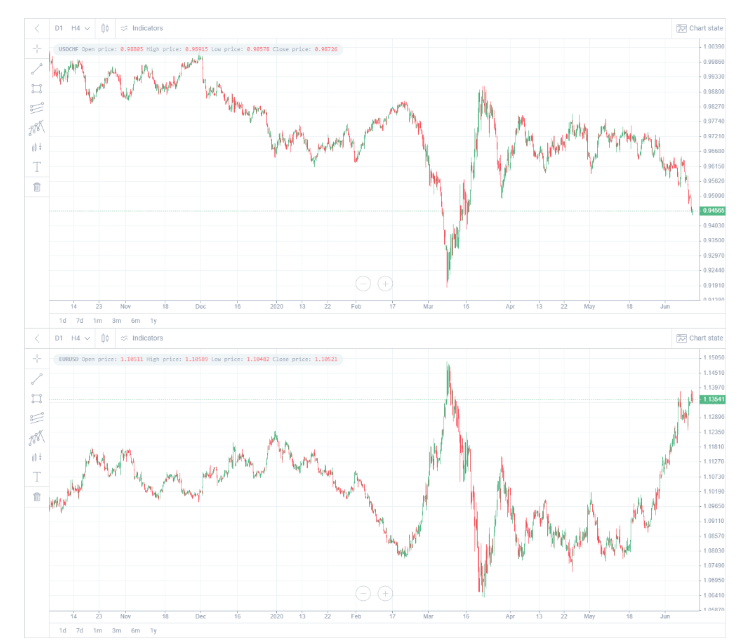Pairs trading in hedging allows traders to gain in both rising and falling markets. It can be used to balance positions and minimize market risk.
In this article, we will discuss how to use pairs trading for hedging.
What is pairs trading?

Pairs trading is a forex trading strategy that involves simultaneously entering a long and short trade in two related correlated currency pairs. Traders aim to gain from the relative price movements of both pairs in falling and rising markets rather than relying only on the overall market direction.
When the correlation between two currency pairs temporarily breaks down, sending one pair into an uptrend and another into a downtrend, a trader can open opposing positions in both. The idea is to gain until the pairs return to their historical average. Underperforming pairs are usually bought, while overperforming pairs are sold.
Example of a pairs trading strategy
Let’s assume a trader wants to trade EUR/USD and GBP/USD, which are highly correlated pairs. Although they move in the same direction most of the time, they occasionally move in opposite directions due to specific factors affecting the Euro or the British Pound.
The trader calculates the spread between the two pairs when EUR/USD is trading at 1.1500 and GBP/USD is trading at 1.2500. The spread comes out to be 1.1000, which is near its historical average. However, a sudden price hike in GBP/USD leads to the pair trading at 1.3500, resulting in the new spread equaling 0.2000 (1.3500-1.1500).
In this situation, the trader longs the underperforming currency pair, EUR/USD, and sells the overperforming currency pair, GBP/USD, to gain from the extensive price move. Over time, markets normalize, and the spread reverts to its historical average. When this happens, EUR/USD rises, and GBP/USD falls to move closer to each other. Both positions can be closed or held at this point.
How does pairs trading help in hedging
- Minimizes market exposure: Pairs trading is a market-neutral strategy, which means the trader enters a long and short trade simultaneously or enters and exits the two pairs. This minimizes exposure to the broad market direction as both positions offset each other
- Reduces directional risk: Directional risk is the risk of prices moving in an unfavorable direction. When a trader holds both long and short positions, they rely less on the market moving in a single direction for gains, and they can take advantage of both falling and rising markets
- Exploits relative value: pairs trading exploits temporary mispricing between two correlated currency pairs. When traders trade the spread between these pairs, they capitalize on the relative value rather than the absolute value
- Mitigates currency-specific risk: Trading pairs with a shared counter-currency, such as the USD, reduces exposure to risks specific to a single currency. For instance, any issues that affect the Euro can be mitigated by the short position opened in GB/USD
- Leverages market inefficiencies: Market inefficiencies are temporary price deviations from normal price correlations. It creates opportunities in pair trading, and traders can gain from the assumption that the pairs will eventually normalize
- Balances long and short positions: Pairs trading balances the risks associated with both long and short positions. This helps traders mitigate and manage the overall portfolio risk better
Indicators that assess correlations between currency pairs
Pearson’s correlation coefficient
Pearson’s correlation coefficient is a statistical measure that calculates the strength and direction of the linear relationship between two currency pairs. The coefficient value ranges from +1 to -1, referring to perfect positive to perfect negative correlation.
Rolling correlation
Rolling correlation is a measure that calculates the correlation coefficient over a specific rolling time window, such as 20 days. It helps understand how the correlation between two currency pairs has changed.
Scatter plot
A scatter plot is a graphical representation that plots the daily returns of one currency pair against another currency pair’s daily returns. A tight and linear scatter plot indicates a strong correlation between the pairs and vice versa. The slope of the line on the scatter plot tells the strength and direction of the relationship.
Coefficient of determination
The coefficient of determination (R² ) is the square of the Pearson correlation coefficient, indicating the proportion of the variance in one currency pair that can be forecasted from another. When the R² value is closer to 1, it suggests a strong correlation, while a value of 0 suggests a weak correlation.
Step-wise guide to use pairs trading for hedging
1. Select currency pairs
Choose two currency pairs that are historically correlated. These pairs should move in a similar direction.
2. Analyze historical correlation
Analyze the historical correlation between the selected pairs to ensure they have a strong relationship. Correlation can be measured using statistical tools like the Pearson correlation coefficient. Look for pairs with a correlation coefficient close to +1, which indicates a strong positive relationship.
3. Identify divergence
Monitor the currency pairs for any divergence from their historical correlation. Divergence occurs when one pair moves significantly more or less than the other. Set up alerts or manually monitor the spread between the pairs.
4. Establish entry points
Analyze technical indicators like moving averages or Bollinger Bands to identify when the divergence peaks and is likely to revert.
5. Implement risk management
Calculate the maximum amount one is willing to lose on the trade and set stop-loss levels accordingly. Ensure that both positions (long and short) have balanced exposure.
6. Monitor the trade
Continuously monitor the trade to ensure it is performing as expected. Watch for signs that the pairs are converging or the divergence is worsening.
7. Close the trade
Exit the trade when the pairs converge to their historical correlation or when the gain target is reached.
Analyzing the market direction with pairs trading indicators
Analyzing market direction using pairs trading indicators involves examining how currency pairs move in relation to each other. The tools help traders understand shifts in market dynamics, enabling informed decisions about hedging forex currencies. By integrating these indicators, traders can better anticipate market movements and refine their strategies for better pair trading.
Disclaimer: All material published on our website is intended for informational purposes only and should not be considered personal advice or recommendation. As margin FX/CFDs are highly leveraged products, your gains and losses are magnified, and you could lose substantially more than your initial deposit. Investing in margin FX/CFDs does not give you any entitlements or rights to the underlying assets (e.g. the right to receive dividend payments). CFDs carry a high risk of investment loss.
Disclaimer: All material published on our website is intended for informational purposes only and should not be considered personal advice or recommendation. As margin FX/CFDs are highly leveraged products, your gains and losses are magnified, and you could lose substantially more than your initial deposit. Investing in margin FX/CFDs does not give you any entitlements or rights to the underlying assets (e.g. the right to receive dividend payments). CFDs carry a high risk of investment loss.




